|
|
|
|
|
|
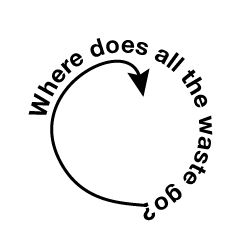
Photography by C. Taylor
![]()
After spending the better part of a day trapped inside a windowless room at 37 S. Wabash, I had to escape. The whole day had been focused on learning about recycling. My only knowledge of Chicago recycling was limited to my apartment building, where we have two blue bins, and I was told I could put anything in them that was recyclable. This didn’t make much sense to me, as I was used to Pittsburgh where cans, plastic, and glass bottles must be separated and put into blue bags which we got at the grocery store—-not by buying them, but because that’s what we carried our groceries in. Paper bags could also be requested, and were used for recycling paper. I guess this was how we answered that age- old question: paper or plastic? It depends, what are you recycling?
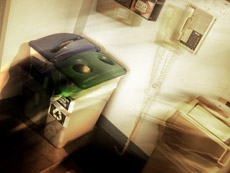 When
I spoke to Mike McNamee of the Resource Center, which is the company that picks
up and recycles the bottles and cans from both the State Street and Chicago
dorms at SAIC, I asked him: paper or plastic? There are problems and issues
that come with recycling. There’s no clear-cut choice. The real answer,
of course, is to bring your own canvas bag to the grocery store. In my conversation
with McNamee when I noted this answer to the question, he agreed, saying that
it usually isn’t hard to come up with a creative solution. “Anything
is recyclable,” McNamee told me, “if someone is willing to build
a factory and remake it into something else.” But that something else
has to be a viable product. This is business, after all, and not much gets done
in America without a profit margin being met.
When
I spoke to Mike McNamee of the Resource Center, which is the company that picks
up and recycles the bottles and cans from both the State Street and Chicago
dorms at SAIC, I asked him: paper or plastic? There are problems and issues
that come with recycling. There’s no clear-cut choice. The real answer,
of course, is to bring your own canvas bag to the grocery store. In my conversation
with McNamee when I noted this answer to the question, he agreed, saying that
it usually isn’t hard to come up with a creative solution. “Anything
is recyclable,” McNamee told me, “if someone is willing to build
a factory and remake it into something else.” But that something else
has to be a viable product. This is business, after all, and not much gets done
in America without a profit margin being met.
The Resource Center is a not-for-profit organization which has been in business for over 25 years. They guarantee in writing that at least 99 percent of the recyclables they pick up from our dorms (and anywhere else they collect recyclables) will be delivered to reuse facilities. This is hugely important in a time when plenty of people don’t bother to recycle because they don’t believe it does any good. I’ve heard plenty of people say that they think it still ends up in a landfill. And this may be the case depending, on who is collecting the recyclables.
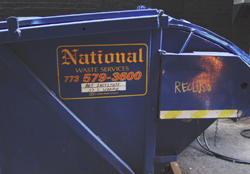 With
the Resource Center picking-up our bottles and cans from the dorms, we can feel
assured that they get another life. Most of it goes through what is called full-circle
recycling. The glass is melted down and remade into glass bottles, clear glass
back into clear glass, brown glass back into brown glass, and green glass back
into green glass. The steel food cans, like soup cans, are sent down to Gary,
Indiana, where they are made back into steel cans. The aluminum cans are made
back into aluminum cans. What isn’t part of full circle recycling is plastic.
By FDA guidelines, plastic can’t be remade into food-grade plastic containers,
because it can’t be heated high enough to kill all the bacteria. Therefore,
the plastics we recycle are made into such things as fleece, plastic lumber,
and non-food containers.
With
the Resource Center picking-up our bottles and cans from the dorms, we can feel
assured that they get another life. Most of it goes through what is called full-circle
recycling. The glass is melted down and remade into glass bottles, clear glass
back into clear glass, brown glass back into brown glass, and green glass back
into green glass. The steel food cans, like soup cans, are sent down to Gary,
Indiana, where they are made back into steel cans. The aluminum cans are made
back into aluminum cans. What isn’t part of full circle recycling is plastic.
By FDA guidelines, plastic can’t be remade into food-grade plastic containers,
because it can’t be heated high enough to kill all the bacteria. Therefore,
the plastics we recycle are made into such things as fleece, plastic lumber,
and non-food containers.
While this is good news, this is only a very small percentage of our refuse at SAIC. After all, the dorms are buildings where the majority of our students, faculty, and staff do not go. In our other buildings on Wabash, Michigan, and Columbus, our Operations Department has set out bins for paper recycling only. Any paper product can be recycled via these bins, that I’m told are in every office in the school and on every floor. Paper, which includes office paper, newspaper, magazines, and cardboard, is able to be recycled everywhere on campus, including the dorms. Plastic, glass, aluminum, and steel, however, are only collected in the dorms. I remember looking for bins to recycle my plastic water bottles when I first got to school here, and I didn’t find any. Now I know that is because those bins aren’t there.
Michael Caronti, assistant director of operations at SAIC, explained to me that we don’t have the facilities to provide bottle and can recycling anywhere else on campus besides the dorms. He said this is because the bottles and cans must be rinsed. He told me of a university he visited in the suburbs of Chicago where student workers take all the bottles and cans to a huge dock area where everything is rinsed. At SAIC, Caronti explained, we don’t have the space or the budget to pay employees to do this. He said he was open to suggestions, a creative solution, as McNamee suggested. We have a creative student body, we should be able to present our operations department with some ideas.
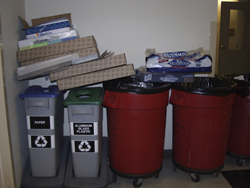 When
I followed up on this, however, McNamee said it is not a requirement that bottles
and cans be rinsed. It’s a suggestion, he explained, for our own comfort,
to cut down on attracting pests and rodents. Of course, the sugary, sweet syrup
residue in an empty soda can exists just the same, whether that can is in a
blue recycling bag, trash bag, or bin. I was excited by this revelation and
went back to Caronti to find out if we might be able to explore adding more
recycling to what we are currently doing, but the story changed.
When
I followed up on this, however, McNamee said it is not a requirement that bottles
and cans be rinsed. It’s a suggestion, he explained, for our own comfort,
to cut down on attracting pests and rodents. Of course, the sugary, sweet syrup
residue in an empty soda can exists just the same, whether that can is in a
blue recycling bag, trash bag, or bin. I was excited by this revelation and
went back to Caronti to find out if we might be able to explore adding more
recycling to what we are currently doing, but the story changed.
When I told Caronti what I had discovered, he said that wasn’t the issue. He told me that National Waste Services, who is contracted by the Art Institute to pick up our trash at both the museum and all the school buildings, sorts out the recyclables at their facility. I asked for a contact at a National Waste to verify this and was not given one. I did, however, speak to Betsy Vandercook who is the president of the Chicago Recycling Coalition, as well as being in charge of the UICycle program at UIC. She was familiar with National and their program. She explained to me that this kind of recycling program is called passive recycling and that this method of recycling gets about a 5 percent rate of recyclables. She explained to me that at UIC, where they have a pretty decent program in place, their recycling rate is about 25 percent. An extraordinary program rate would be 60 percent.
As McNamee asserted, “People need to insist that big organizations that we support in the course of our daily life be responsible to us, like government, academic institutions, and corporations.” The creative solutions he mentioned can only happen if people are willing to look hard at the actual results, and if people are willing to check that things are actually being recycled. He was willing to concede, though, that there are only so many hours in the day.
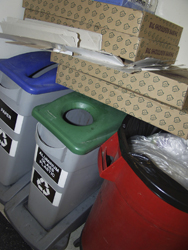 To
me, this raises the question for the school, though: should we be settling for
this level of recycling when we could be doing more? When I asked McNamee if
the Resource Center performed any community outreach, he said yes, that they
had recently worked with a student group at Columbia College. Could they come
to SAIC, I wondered? Actually, they already have. Three years ago, McNamee said,
someone from his company came to SAIC to work with a student organization. This
is when recycling was started in the dorms. This was confirmed by Caronti, who
said that the reason we have bottle and can recycling in the dorms is because
the students asked for it. As for why we have paper recycling, Caronti couldn’t
tell me. The person who started that program over ten years ago no longer works
at SAIC.
To
me, this raises the question for the school, though: should we be settling for
this level of recycling when we could be doing more? When I asked McNamee if
the Resource Center performed any community outreach, he said yes, that they
had recently worked with a student group at Columbia College. Could they come
to SAIC, I wondered? Actually, they already have. Three years ago, McNamee said,
someone from his company came to SAIC to work with a student organization. This
is when recycling was started in the dorms. This was confirmed by Caronti, who
said that the reason we have bottle and can recycling in the dorms is because
the students asked for it. As for why we have paper recycling, Caronti couldn’t
tell me. The person who started that program over ten years ago no longer works
at SAIC.
I am left wondering if we as a school community would really be satisfied with our current recycling program if we knew it could be so easy to do more? The one thing we are making a noticeable effort on is paper recycling. Our paper recycling is picked up by Recycling Services, Inc., who also contracts out our bottle and can recycling to the Resource Center. Michelle Mohney at Recycling Services, Inc., explained what happens to our paper. After it is picked up from our buildings, the truck takes it back to their processing facility where it “is blended with papers from other sources. The paper is then put through a filtration system and further blended with papers from other sources. All the paper is then baled. Full truck-loads of bales are shipped to mills throughout the United States. The entire process from time of pick-up at the customers’ location to delivery to the mills is typically 24 to 48 hours.”
For the entire 2003 year, the Art Institute recycled just over 68 tons of material. Of that 68 tons, a little over 35 tons came from the School (the rest came from the museum). Mohney explains that the standard equations developed by the American Forest & Paper Association say that for every one ton of paper recycled, 17 trees are saved, 7000 gallons of water are conserved, and 60 pounds of pollutants are prevented from entering the atmosphere. This makes our conservation effort sound great, but it also reminds me of how much better we could be doing. Caronti agreed that we could do better, saying, “We saved seven trees in one month. That’s pretty darn good, man. Can you always do better? Of course. Humans can always do better.”
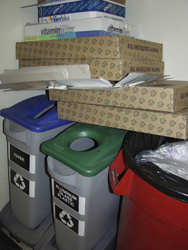 I
want to believe that we are headed in a progressive direction, but the more
I tried to unravel things the more explanations got convoluted. I’m left
feeling concerned that the School is going to accept the status quo, when we
could be taking an active role and doing so much more. It was the students who
brought bottle and can recycling to the dorms. Perhaps it will be the students
who bring bottle and can recycling to our other buildings as well.
I
want to believe that we are headed in a progressive direction, but the more
I tried to unravel things the more explanations got convoluted. I’m left
feeling concerned that the School is going to accept the status quo, when we
could be taking an active role and doing so much more. It was the students who
brought bottle and can recycling to the dorms. Perhaps it will be the students
who bring bottle and can recycling to our other buildings as well.
At the end of the day, I left my windowless space to get some fresh air on a beautiful day. Walking south on Wabash I saw a shiny blue, new-looking truck with the words, “National Waste Services,” and a phone number painted on the side. It was getting trash from a dumpster in the alley between Wabash and Michigan. The cleanliness and the blue color of the truck brought to mind recycling, but as I walked down Adams, I passed the truck and could see the black trash bags dumping into the truck. From there I headed to get a sandwich that was wrapped in aluminum foil. I brought it back to the school, ate my sandwich, and folded up the aluminum foil to take home where I could recycle it. Or, better yet, I’ll probably save it and use it again later to wrap something I’ve brought home from the grocery store in my own bag, carrying it on my own two feet, powered by the sandwich I just ate—my own little cycle of conservation.Editor’s note: At press time, we called National Waste and spoke with Morgan Dodge who said that at the transfer station, “there is no sorting of anything.” Thus, none of SAIC’s waste that is being hauled away in regular garbage dumpsters is recycled. According to the Operations Department, paper is being put in special recycling dumpsters and is, indeed, being recycled. —mmg
|
|
|
|
|
|